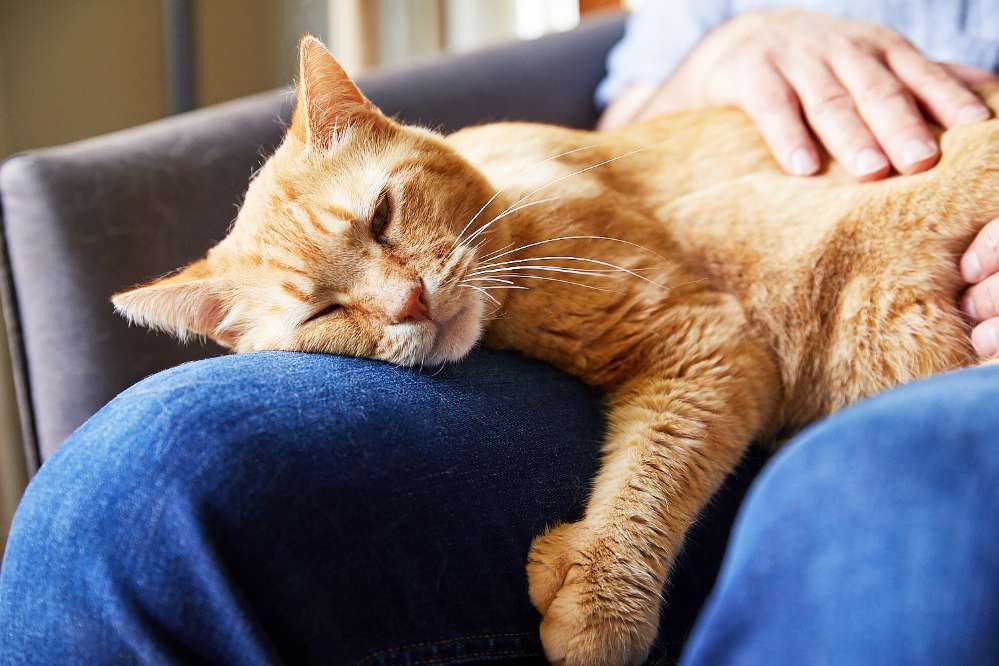how to tell if your pet is in pain (and how you can help!)
If pets could talk, they’d probably tell us all kinds of things — like their favorite neighborhood sniffs, how they deserve a million treats a day, and that we could use a singing lesson (or two). They’d also tell us when they’re not feeling well. But since they can’t, we're left figuring it out in other ways.
Below, we’ll tell you what signs of pain to look out for, how you can help, and how to partner with your vet through it all.
Thanks to our friends at the American Animal Hospital Association (AAHA) for providing some of the following content.
How do you know a dog is in pain? How about a cat?
Pets typically show pain through behavioral changes. While these may be apparent in dogs, cats are notoriously good at hiding their pain — so you may need to be extra observant with feline friends.
Commons signs of pain in dogs and cats:
- Slow to rise
- Changes in how a cat goes up/down steps or jumps on/off things
- Going to the bathroom outside the litter box
- Less interest in play
- Decreased grooming
- Inability or hiding
- Licking or chewing a certain spot
- Less energy, increased sleeping
- Difficulty with or avoiding stairs
Other signs of pain may include excessive vocalizing, hunched posture, and decreased appetite. Really, though, if you notice any changes in your dog or cat, it’s a good idea to see your vet.
Ways to help ease your pet’s pain at home
Depending on the source and severity of your pet’s pain, there are some simple changes you can make at home to help them out.
- Create a low-impact exercise routine
Many pets benefit from regular low-impact exercise to keep muscle strength up and body weight down. - Try some non-slip flooring
Stairs, tiles, and wood floors can be difficult to navigate for a pet who's in pain. Adding rugs or yoga mats to areas they frequent can provide some relief. - Think of bowl placement
Your dog or cat might not be comfortable leaning down to drink or eat anymore. Look for elevated and/or titled bowls that make the process easier. - Visit your vet
Based on your pet’s exam and history, your vet may have recommendations for specific food, treats, supplements, or medications that may help with pain. - Keep your litter boxes low
Many cats with arthritis have difficulty climbing in and out of litter boxes. Use low entry boxes, and ideally have one more than the number of cats in your household. - Think of bowl placement
Your dog or cat might not be comfortable leaning down to drink or eat anymore. Look for elevated and/or titled bowls that make the process easier.
How to advocate for your pet
It can be frustrating not knowing how your sweet pet is feeling. Here’s how you can stay on top of their pain management and get a little peace of mind.
- Look for changes in pet's behavior, appearance, habits, etc.
- Learn the signs of pain
- Take a video of any new symptoms
- Write down detailed observations
- Share with your veterinary team
- Adjust treatment (with guidance from vet) accordingly
Partnering with your vet
Assessing and treating your pet’s pain takes a strong partnership between you and your vet.
Your vet will assess your pet for pain during a physical exam. They’ll also ask you questions about how your pet is doing at home and may have you fill out an assessment of your pet’s pain (this is where writing down those detailed observations will be helpful).
The assessment will help your vet determine the frequency, duration, and severity of your pet’s pain. Examples of assessments include the Feline Grimace Scale, the Liverpool Osteoarthritis in Dogs questionnaire, and the Canine Brief Pain Inventory.
How can I comfort my dog in pain? How to comfort a cat in pain?
The best thing you can do is take your dog or cat to the vet. They’ll be able to recommend treatment and home changes to help your pet find relief.
 Mites and mange
Mites and mange Podcast - Not Just Fluff
Podcast - Not Just Fluff











